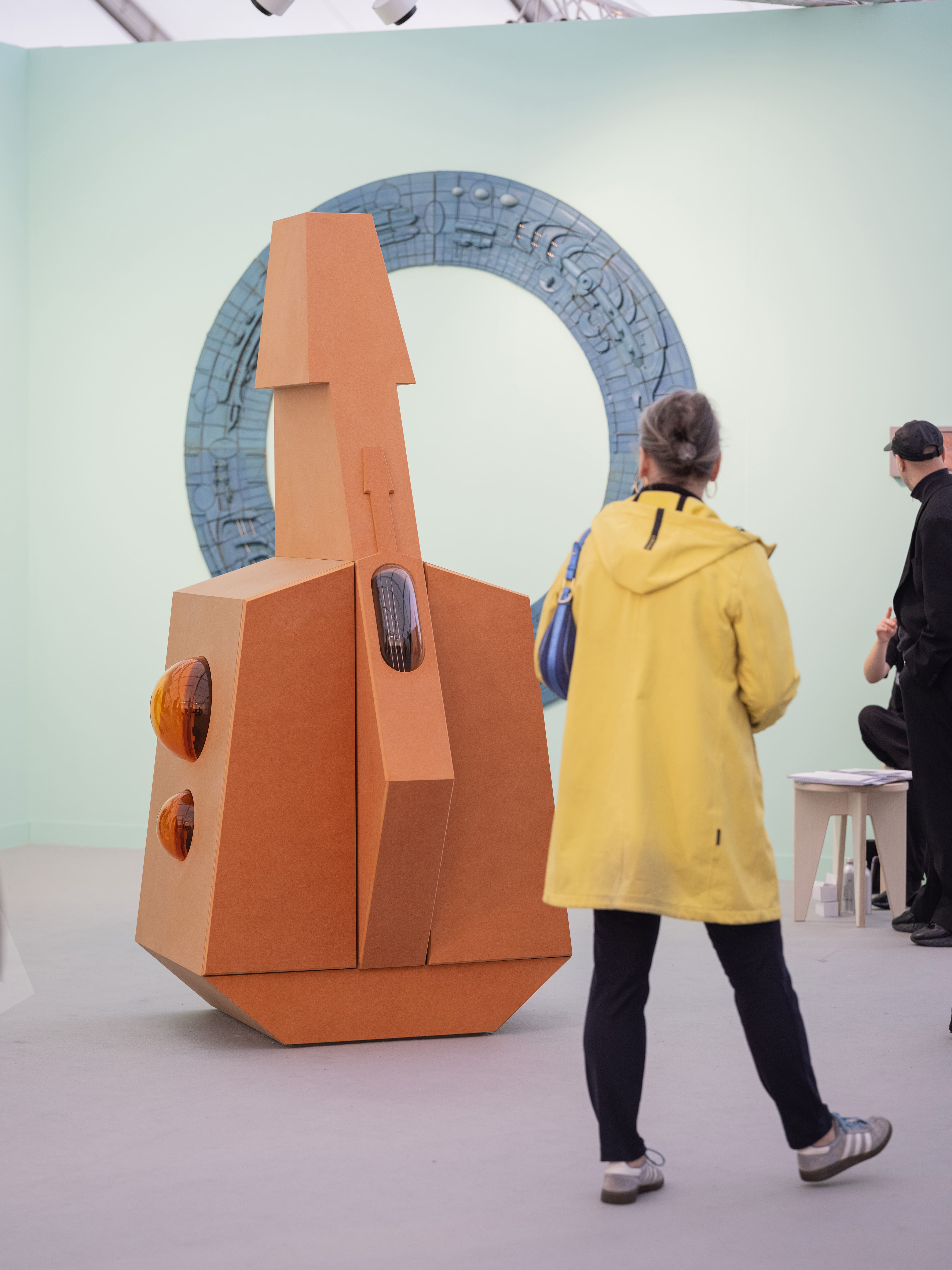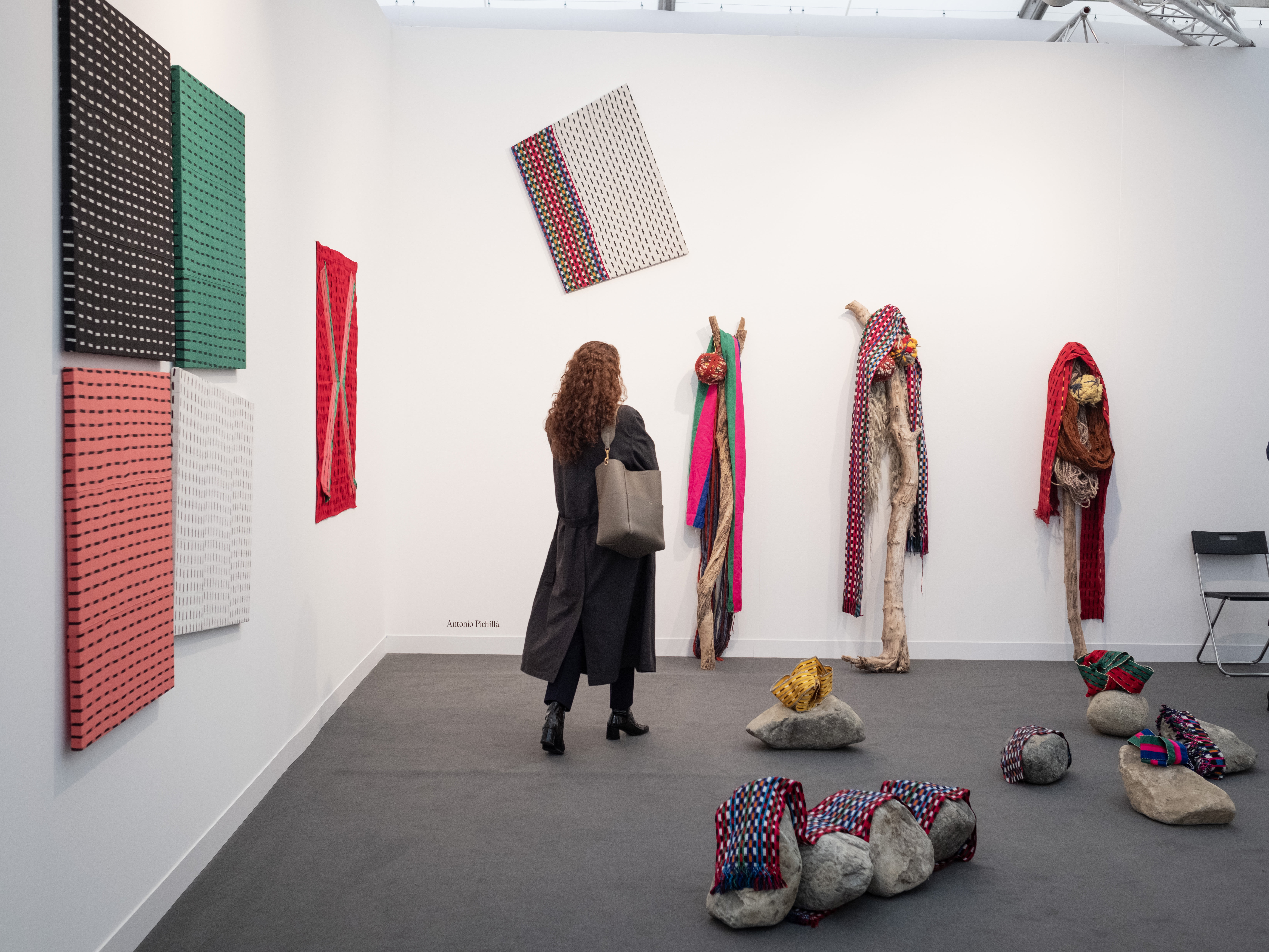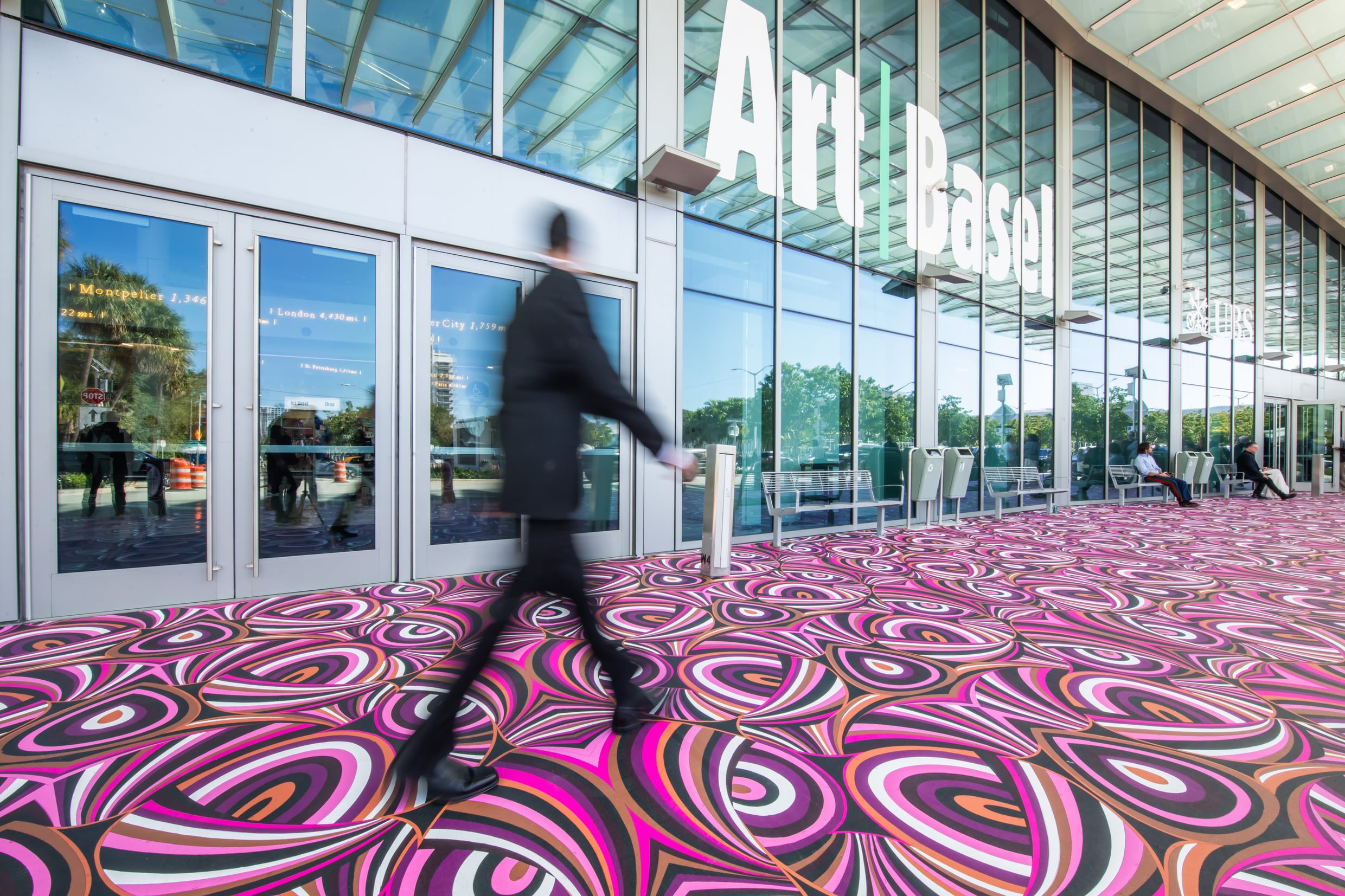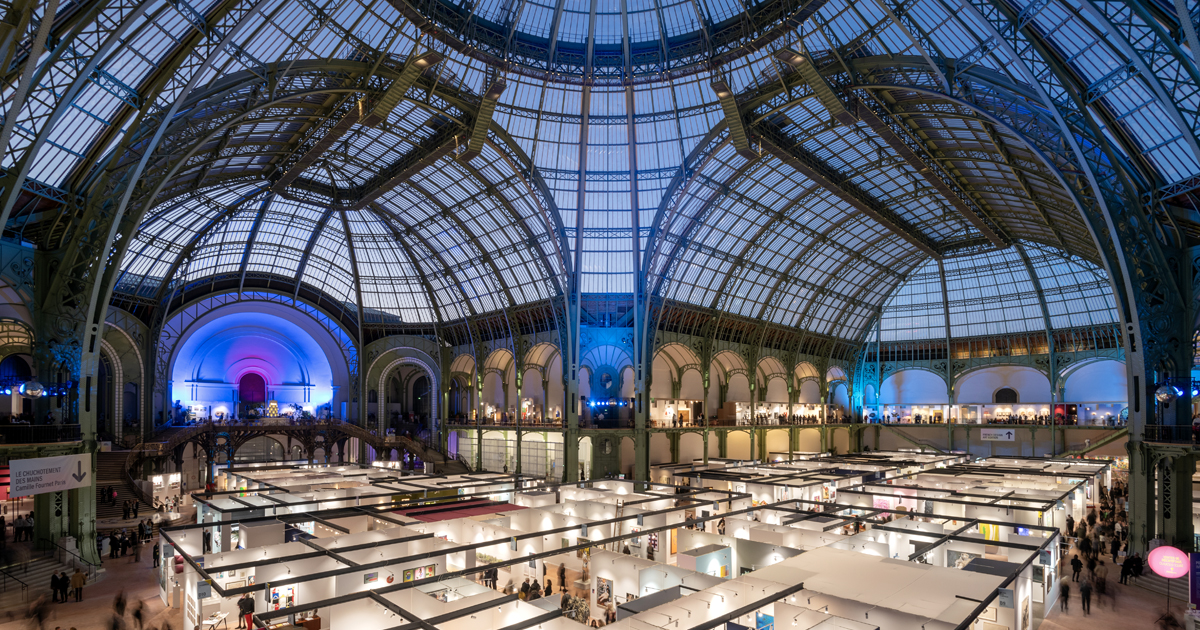Máret Ánne Sara’s Goavve-Geabbil transforms Tate Modern into a living landscape of hides, bone, sound, and spirit. Rooted in Sámi cosmology, the installation marks a powerful return of shamanic presence in contemporary art—an immersive call to reconnect with land, ancestors, and the unseen.
Frieze London and Frieze Masters 2025: A Market in Motion
Frieze 2025 flipped the script. Emerging voices took the spotlight, performance met sculpture, and ancestral rituals mingled with futuristic visions. Blue-chip certainty met daring risk.
.jpg)
Frieze London and Frieze Masters 2025 opened at Regent’s Park with the usual cocktail of anticipation, polished shoes, and quiet competition—but something felt different this year. The fair exuded a new kind of confidence, the sort that doesn’t shout but knows exactly what it’s doing. Collectors arrived ready, phones buzzing early, and Hauser & Wirth set the tone at Frieze Masters, placing Gabriele Münter’s Der blaue Garten (Mein Gartentor) (1909) for CHF 2.4 million ($3.01 million). A neat reminder that historical depth still commands attention in a market often addicted to the next new thing.
But the real story wasn’t the sales it was the atmosphere. Younger galleries—those under twelve years old— greeted visitors first, nudging aside the old guard with quiet nerve. A bold and refreshing move: less velvet rope, more open conversation with the front of the fair feeling alive—charged, curious, and willing to take risks.

Across the park, Frieze Masters held its ground with trademark elegance. Under new director Emanuela Tarizzo, this year’s exhibitors offered a seamlessly curated dialogue. Tate, ever the discreet shopper, added Lubna Chowdhary’s Assembly (2025) and Barbara Walker’s End of the Affair II (2025) through the Frieze Tate Fund. Yet the most interesting shift this year isn’t in what sold, but how it was shown. Many galleries dialed down the bravado and turned up the brains—curating booths that read like essays rather than advertisements. Frieze 2025, in other words, is proof that even an art fair can learn to edit itself.
If Frieze London 2025 had a booth that felt like a therapy session disguised as performance art, it was LLANO’s. For their third outing at the fair, the Mexico City gallery (helmed by Mauricio Caldena) presented a brilliant, disarming installation by Enrique López Llamas—a young artist whose work turns failure into both subject and spectacle. Anchored by the 16-part video suite El otro protagonista de la noche (The Other Protagonist of the Night, 2025), the installation unfolds like a coming-of-age story played on fast-forward: self-doubt, delusion, shame, and performance all loop through the Sisyphean rituals of becoming an artist—or, really, an adult.
.jpg)
López Llamas’s language is fluent in both art history and meme culture. His videos riff on slapstick and self-sabotage—somewhere between Buster Keaton and Jackass—while his hand-painted props and sculpture slitter the space like relics of a manic rehearsal. Humor cuts close to the bone: the artist interrogates the cult of genius, the fetish of productivity, and the collective hangover of millennial self-consciousness. Even his aesthetic nods—Michael Jackson, corporate masculinity, the clown mask, TikTok timing—function like pop Freudian slips: the devices we use to perform ourselves until we forget who’s acting.
LLANO’s curatorial finesse amplifies the effect. The gallery’s immersive, research-driven approach makes the booth feel simultaneously like a stage, a rehearsal space, and a confessional. Collectors are presented not just with objects to acquire, but with a conceptual ecosystem in which contemporary sculpture becomes a vessel for narrative, memory, and the enduring work of becoming. Amid a fair dominated by polished surfaces and predictable displays, LLANO offers risk, wit, and conceptual rigor. For those attuned to the possibilities of sculpture today, López Llamas’s booth is more than a highlight—it’s a conversation starter, an experience, and a collection-worthy proposition.
For the ones drawn to work at the intersection of body, technology, and culture, Rafał Zajko’s Song to the Siren (Echo) at Coulisse Gallery was a standout. Zajko destabilizes linear narratives, merging memories of post-communist Poland with the pressures of contemporary London life, creating a speculative, queerly inventive vision of the world. His sculptures and installations resonate with intellectual depth and performative vitality, offering a dialogue between past, present, and an imagined future.

At the heart of the booth is Amber Chamber III, an inhabitable sculpture crafted from modern valchromat and hand-laid terracotta tiles. Daily performative actions by Agnieszka Szczotka animate the chamber, extending its material presence into a living exploration of bodily and architectural rhythms. Zajko reinterprets the siren—from mythical lure to industrial signal—as a meditation on perception, alertness, and collective experience. Through motifs of civil defence alarms, vocal anatomy, and symphonic layouts, the work evokes transhumanist themes, suggesting a fluid relationship between human bodies, technological systems, and spatial environments.
And Rafal Zajko is compelling: his work is already held in prominent collections including Arts Council England and M WOODS Collection, China. Recent solo exhibitions include Focal Point Gallery, UK (2025), and the Kunsthalle Wien commission Bread and Milk (2023). With a growing international profile and a practice that merges sculptural innovation with performance, Zajko offers both aesthetic significance and long-term cultural relevance.
While Zajko’s work navigates technology and performance, Antonio Pichillá’s Earth Knots at Portas Vilaseca offers a profoundly shamanic perspective—art that speaks through ancestral memory, ritual, and materiality. Rooted in his Maya-Tz’utujil heritage, Pichillá reclaims Indigenous narratives, weaving together objects, textiles, and stone to challenge colonial histories while asserting continuity with the past.

Central to the exhibition are the Spantajeros series, sculptural forms derived from traditional objects designed to protect growing plants, alongside floor sculptures merging stones from Lake Atitlán with handwoven textiles. In the video Tejer el Paisaje, the simple act of stretching threads becomes a contemplative ritual, underscoring the intimate link between human practice and the natural world. Geometric motifs and intricate knots recur across the works, serving as both metaphor and method: threads connect past and present, weaving a visual language of resilience, knowledge, and collective memory.
Pichillá’s multidisciplinary practice spans textile art, painting, video, and installation, attentive to the rhythms, symbols, and cosmologies of his community. His works are represented in major collections including Museo Reina Sofía, Tate Modern, and Museo MALBA, and his recent solo exhibitions include Abuela Materna in Madrid (2025) and Daritev / The Offering in Ljubljana (2024). For collectors interested in art that foregrounds ancestral wisdom, ritualized labor, and material poetics, Pichillá offers a rare opportunity: art deeply rooted in Indigenous knowledge yet resonant within global contemporary discourse.
Frieze London and Frieze Masters 2025 offered a market snapshot in motion—where institutional confidence met collector curiosity. Tate’s acquisitions of Lubna Chowdhary and Barbara Walker, alongside Arts Council picks of Alex Margo Arden, Olu Ogunnaike, and Vanessa Raw, signal a decisive focus on new voices. These are artists stepping from the margins into long-term institutional memory, and acquisitions at this stage often carry both cultural and financial upside.
-min.jpg)
Meanwhile, at Frieze Masters, the market’s upper tier hummed with confidence as Hauser & Wirth sold Münter’s Der blaue Garten, confirming that canonical modernism remains a safe harbor. Yet across Regent’s Park, real vitality was found in Focus and Artist-to-Artist, where names like Bogdan Ablozhnyy, Michelle Uckotter, and Neal Tait with Lungley Gallery drew serious attention. Supported by Tiffany & Co., these curated sections remain launchpads—places where collectors can discover artists before the secondary market and institutions formalize their ascent.
For those building a collection with longevity in mind, this year’s fair made one thing clear: pair blue-chip anchors with emerging artists gaining institutional traction, and don’t overlook sculpture—from Michael Landy’s kinetic Multi-Saint to Chowdhary’s ceramic works, three-dimensional pieces are reclaiming relevance. The best collections of 2025 will balance adventure and assurance, proof that the art market, like great art itself, thrives on tension, timing, and a little nerve.
Frieze London 2025 offers a revealing snapshot of an art market entering its age of caution, framed this year by a curatorial tension between technology and new-age shamanism—a longing to reconcile digital hypermodernity with ancestral intuition.
The fair’s immaculate presentations and familiar blue-chip rosters signal a shift from speculation to stability: collectors are buying less impulsively, seeking artists with institutional credibility and proven track records. Risk-taking has retreated to the margins, replaced by a “curated safety,” even as many artists gesture toward healing, ritual, and ecological reconnection as counterweights to technological alienation.

The speculative frenzy of the early 2020s has cooled into a sober, data-driven market logic—art as asset rather than adventure—yet beneath this composure, subtle transformations are taking root. Galleries from Africa, Latin America, and Southeast Asia are gaining traction, suggesting a gradual redistribution of legitimacy away from traditional Western centers.
The result is a market that feels mature but spiritually restless, stable yet searching for meaning. If this is the future, it’s one defined by control and yearning: a post-speculative era in which the art world, wary of volatility, turns back toward ritual, myth, and memory in hopes of remembering what it means to feel human.
Miami Beach is about to trade in its sunscreen for art, ambition, and audacity, as Art Basel 2025 takes over the city in a whirlwind of color, ideas, and unapologetic creativity. From Havana to São Paulo, New York to Kyiv, 283 galleries are landing in the Sunshine State, bringing a global parade of Modern masters, postwar icons, and daring emerging voices. This year, the fair is shining a spotlight on Latinx, Indigenous, and diasporic artists—because if Miami is the crossroads of the Americas, Art Basel is the crossroads of ideas. Get ready for a week where the beach vibes meet bold statements, and the cocktail of culture is curated with intellectual rigor.
The latest Art Basel & UBS Survey of Global Collecting reveals a new balance of power in the art world — where women lead in spending, Gen Z embraces digital art, and collecting becomes as much about identity as investment.

-min.jpeg)

